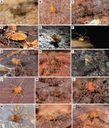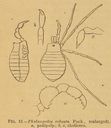Travunioidea
Travunioidea
Classification
- Phylum: Arthropoda
- Subphylum: Chelicerata
- Class: Arachnida
- Order: Opiliones
- Suborder: Laniatores
- Superfamily: Travunioidea
Pronunciation
How to pronounce Travunioidea: /trɑvʊˈni.oɪd.eɪə/
These audio files are automatically generated. While they are not always 100% accurate, they are a good starting point.
Images






Summary
Travunioidea is a superfamily of armoured harvestmen within the order Opiliones, characterized by their unique morphology and ecological roles.
Physical Characteristics
Armoured body structure characteristic of harvestmen.
Identification Tips
Typically identified by their armored appearance and unique morphological traits depending on the specific family.
Habitat
Primarily found in terrestrial environments, often in leaf litter or under stones.
Distribution
Approximately 75 described species; distribution largely depends on the family, with some species found in specific regions.
Diet
Feeds on small invertebrates and detritus, typical of most harvestmen.
Life Cycle
Complex life cycle encompassing eggs, juvenile stages, and adults; specifics may vary among families.
Reproduction
Reproductive habits include external fertilization, with males typically engaging in courtship displays.
Predators
Natural predators include birds, amphibians, and other arachnids.
Ecosystem Role
Integral role in the decomposition process, contributing to nutrient cycling.
Collecting Methods
- Hand collection
- Pitfall traps
- Leaf litter sampling
Preservation Methods
- Ethanol preservation
- Drying methods
- Pinning for morphological studies
Evolution
Part of the evolutionary lineage leading to modern arachnids, distinct from other arachnid orders.
Similar Taxa
- Phalangida
- Scutigeromorpha
- Amblypygi
Misconceptions
Often confused with spiders, though they are distinct in ecological roles and anatomy.
Tags
- arachnology
- harvestmen
- travunioidea
- opiliones
- biodiversity